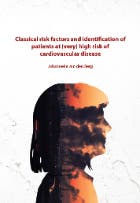Johanneke van den Berg
Classical riskfactors and identification of patients at (very) high risk of cardiovascular disease

- Datum
- (Co) promotoren
- 30-11-2017
- Prof. F.L.J. Visseren, PhD ; prof Y. van der Graaf, PhD
Samenvatting
There is a wide distribution of predicted 10-year vascular risk and in general all patients with clinically manifest arterial disease are considered to be at high risk for a recurrent cardiovascular event. Stratification into high or very high risk is relevant, since patients at highest risk might have more benefit of stricter risk factor goals or prescription of novel (often expensive) therapy. Patients with vascular disease who smoke, have diabetes, dyslipidemia or progression of coronary artery disease are considered to be at very high risk by the American College of Cardiology / American Heart Association (ACC/AHA). Approximately 60% of patients with manifest arterial disease meet the ACC/AHA very high risk criteria. Performance (based on incidence rates of recurrent cardiovascular events, C-statistics and net reclassification index) of this set of simple criteria appears to have limited discriminative power. Recurrent cardiovascular events in relative young patients, or recurrent cardiovascular events within a short time span indicate critical progression of atherosclerosis which deserves priority by patients and physicians. Smoking, blood pressure and lipids were related to risk of recurrent cardiovascular events in patients at relative young age (<65 years) and to risk of recurrent cardiovascular events within a short time span (< 2.5 years) after a first cardiovascular event. Achieving the 2016 ESC risk factor targets for smoking was related to decreased risk of recurrent MACE in these patients and in addition, physical activity and a normal weight (BMI 20-25kg/m2 with a waist circumference of <80 cm in women and <94 cm in men) were related to decreased risk of recurrent cardiovascular events within a short time span, irrespective of age. In clinical practice, LDL-cholesterol (LDL-C) is used as the main lipid parameter i.e. to assess vascular risk and as primary treatment target. However, there is a growing body of evidence suggesting that other lipid parameters: triglycerides, non-HDL-cholesterol (non-HDL-C) or apolipoprotein B (apoB) might be superior in estimating vascular risk. High levels of all lipid parameters were related to risk of future cardiovascular events. In patients with cerebrovascular, coronary artery or polyvascular disease, non-HDL-C and LDL-C had the strongest relation with vascular risk with comparable magnitude. Although the harmful effects of smoking on health are widely known, a substantial proportion of patients with vascular disease continues to smoke. Patients who reported smoking cessation after a first cardiovascular event had an average gain of 5 life years and delayed recurrent MACE with 10 years. Also in patients with a first CV event >70 years, cessation of smoking improved survival which on average was comparable to former or never smokers. Since smoking cessation is more effective in reducing CV risk than any pharmaceutical treatment of major risk factors, it should be a key objective for patients with a recent clinical manifestation of vascular disease and for their physicians. Although many risk factors in secondary prevention are increasingly controlled or treated, the prevalence of obesity is rising. Obesity often comes together with hypertension, dyslipidemia and insulin resistance and leads to increased risk of (cardiovascular) morbidity and mortality. At onset of cardiovascular disease, two-thirds of the patients are overweight or obese. With aging, the average BMI continued to increase, with highest increase seen in the youngest patients (< 50 years), in patients with diabetes or with coronary artery disease. Weight gain management in cardiovascular disease prevention should focus on younger patients, since they showed highest increase in BMI.
